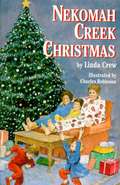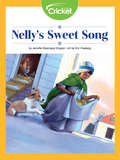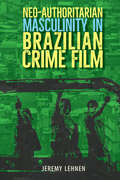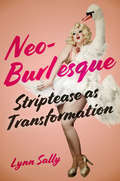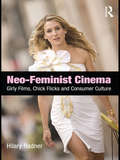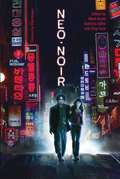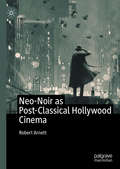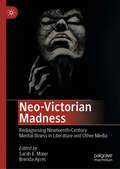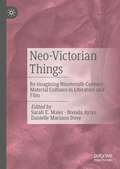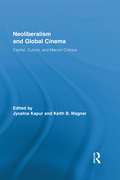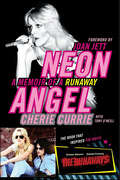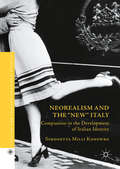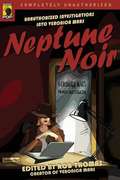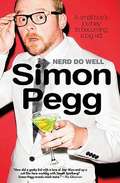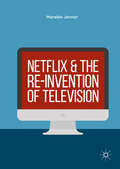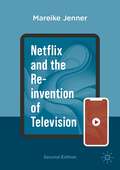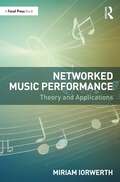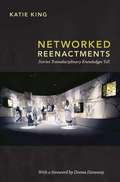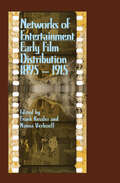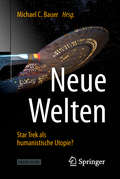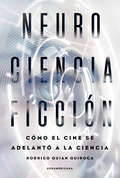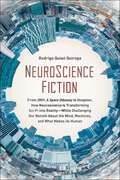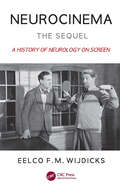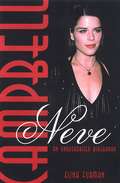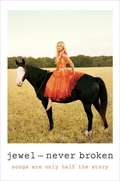- Table View
- List View
Nekomah Creek Christmas
by Linda CrewRobby Hummer loves everything about Christmas except the school play. He dreads being an elf in green tights.
Nelly's Sweet Song
by Jennifer Riesmeyer ElvgrenNelly’s grandfather has been away fighting in the Revolutionary War. Her entire family wants to make the homecoming special, but Nelly keeps causing trouble! What can she do to welcome him home?
Neo-Authoritarian Masculinity in Brazilian Crime Film (Reframing Media, Technology, and Culture in Latin/o America)
by Jeremy LehnenAnalyzing how masculinity is portrayed in Brazilian crime film, connecting movie messages to twenty-first-century issues An incisive analysis of contemporary crime film in Brazil, this book focuses on how movies in this genre represent masculinity and how their messages connect to twenty-first-century sociopolitical issues. Jeremy Lehnen argues that these films promote an agenda in support of the nation’s recent swing toward authoritarianism that culminated in the 2018 election of far-right president Jair Bolsonaro. Lehnen examines the integral role of masculinity in several archetypal crime films, most of which foreground urban violence, including Cidade de Deus, Quase Dois Irmãos, Tropa de Elite, O Homem do Ano, and O Doutrinador. Within these films, Lehnen finds representations that criminalize the poor, marginalized male; emasculate the civilian middle-class male intellectual, casting him as unable to respond to crime; and portray state security as the only power able to stem increasing crime rates. Drawing on insights from masculinity studies, Lehnen contends that Brazilian crime films are ideologically charged mediums that assert and normalize the presence of the neo-authoritarian male within society. This book demonstrates how gendered scripts can become widely accepted by audiences and contribute to very real power structures beyond the sphere of cinema. A volume in the series Reframing Media, Technology, and Culture in Latin/o America, edited by Héctor Fernández L’Hoeste and Juan Carlos RodríguezPublication of this work made possible by a Sustaining the Humanities through the American Rescue Plan grant from the National Endowment for the Humanities.
Neo-Burlesque: Striptease as Transformation
by Lynn SallyThe neo-burlesque movement seeks to restore a sense of glamour, theatricality, and humor to striptease. Neo-burlesque performers strut their stuff in front of audiences that appreciate their playful brand of pro-sex, often gender-bending, feminism. Performance studies scholar and acclaimed burlesque artist Lynn Sally offers an inside look at the history, culture, and philosophy of New York’s neo-burlesque scene. Revealing how twenty-first century neo-burlesque is in constant dialogue with the classic burlesque of the nineteenth and twentieth centuries, she considers how today’s performers use camp to comment on preconceived notions of femininity. She also explores how the striptease performer directs the audience’s gaze, putting on layers of meaning while taking off layers of clothing. Through detailed profiles of iconic neo-burlesque performers such as Dita Von Teese, Dirty Martini, Julie Atlas Muz, and World Famous *BOB*, this book makes the case for understanding neo-burlesque as a new sexual revolution. Yet it also examines the broader community of “Pro-Am” performers who use neo-burlesque as a liberating vehicle for self-expression. Raising important questions about what feminism looks like, Neo-Burlesque celebrates a revolutionary performing art and participatory culture whose acts have political reverberations, both onstage and off.
Neo-Feminist Cinema: Girly Films, Chick Flicks, and Consumer Culture
by Hilary RadnerWhat lies behind current feminist discontent with contemporary cinema? Through a combination of cultural and industry analysis, Hilary Radner’s Neo-Feminist Cinema: Girly Films, Chick Flicks and Consumer Culture shows how the needs of conglomerate Hollywood have encouraged an emphasis on consumer culture within films made for women. By exploring a number of representative "girly films," including Pretty Woman, Legally Blonde, Maid in Manhattan, The Devil Wears Prada, and Sex and the City: The Movie, Radner proposes that rather than being "post-feminist," as is usually assumed, such films are better described as "neo-feminist." Examining their narrative format, as it revolves around the story of an ambitious unmarried woman who defines herself through consumer culture as much as through work or romance, Radner argues that these films exemplify neo-liberalist values rather than those of feminism. As such, Neo-Feminist Cinema offers a new explanation as to why feminist-oriented scholars and audiences who are seeking more than "labels and love" from their film experience have viewed recent "girly films" as a betrayal of second-wave feminism, and why, on the other hand, such films have proven to be so successful at the box office.
Neo-Noir (Wallflower Press #PPCS)
by Mark Bould Greg Tuck Kathrina GlitreNeo-noir knows its past. It knows the rules of the game – and how to break them. From Point Blank (1998) to Oldboy (2003), from Get Carter (2000) to 36 Quai des Orfèvres (2004), from Catherine Tramell to Max Payne, neo-noir is a transnational global phenomenon. This wide-ranging collection maps out the terrain, combining genre, stylistic and textual analysis with Marxist, feminist, psychoanalytic and industrial approaches. Essays discuss works from the US, UK, France, Japan, South Korea, Hong Kong and New Zealand; key figures, such as David Lynch, the Coen Brothers, Quentin Tarantino and Sharon Stone; major conventions, such as the femme fatale, paranoia, anxiety, the city and the threat to the self; and the use of sound and colour.
Neo-Noir as Post-Classical Hollywood Cinema
by Robert ArnettNeo-Noir as Post-Classical Hollywood Cinema suggests the terms “noir” and “neo-noir” have been rendered almost meaningless by overuse. The book seeks to re-establish a purpose for neo-noir films and re-consider the organization of 60 years of neo-noir films. Using the notion of post-classical, the book establishes how neo-noir breaks into many movements, some based on time and others based on thematic similarities. The combined movements then form a mosaic of neo-noir. The time-based movements examine Transitional Noir (1960s-early 1970s), Hollywood Renaissance Noir in the 1970s, Eighties Noir, Nineties Noir, and Digital Noir of the 2000s. The thematic movements explore Nostalgia Noir, Hybrid Noir, and Remake and Homage Noir. Academics as well as film buffs will find this book appealing as it deconstructs popular films and places them within new contexts.
Neo-Victorian Madness: Rediagnosing Nineteenth-Century Mental Illness in Literature and Other Media
by Brenda Ayres Sarah E. MaierNeo-Victorian Madness: Rediagnosing Nineteenth-Century Mental Illness in Literature and Other Media investigates contemporary fiction, cinema and television shows set in the Victorian period that depict mad murderers, lunatic doctors, social dis/ease and madhouses as if many Victorians were “mad.” Such portraits demand a “rediagnosing” of mental illness that was often reduced to only female hysteria or a general malaise in nineteenth-century renditions. This collection of essays explores questions of neo-Victorian representations of moral insanity, mental illness, disturbed psyches or non-normative imaginings as well as considers the important issues of legal righteousness, social responsibility or methods of restraint and corrupt incarcerations. The chapters investigate the self-conscious re-visions, legacies and lessons of nineteenth-century discourses of madness and/or those persons presumed mad rediagnosed by present-day (neo-Victorian) representations informed by post-nineteenth-century psychological insights.
Neo-Victorian Things: Re-imagining Nineteenth-Century Material Cultures in Literature and Film
by Brenda Ayres Sarah E. Maier Danielle Mariann DoveNeo-Victorian Things: Re-Imagining Nineteenth-Century Material Cultures in Literature and Film is the first volume to focus solely on the replication, reconstruction, and re-presentation of Victorian things. It investigates the role of materiality in contemporary returns to the past as a means of assessing the function of things in remembering, revisioning, and/or reimagining the nineteenth century. Examining iterations of material culture in literature, film and popular television series, this volume offers a reconsideration of nineteenth-century things and the neo-Victorian cultural forms that they have inspired, animated, and even haunted. By turning to new and relatively underexplored strands of neo-Victorian materiality—including opium paraphernalia, slave ships, clothing, and biographical objects—and interrogating the critical role such objects play in reconstructing the past, this volume offers ways of thinking about how mis/apprehensions of material culture in the nineteenth century continue to shape our present understanding of things.
Neoliberalism and Global Cinema: Capital, Culture, and Marxist Critique (Routledge Advances in Film Studies)
by Keith B. Wagner Jyotsna KapurIn cinema studies today, rarely do we find a direct investigation into the culture of capitalism and how it has been refracted and fabricated in global cinema production under neoliberalism. However, the current economic crisis and the subsequent Wall Street bailout in 2008 have brought about a worldwide skepticism regarding the last four decades of economic restructuring and the culture that has accompanied it. In this edited volume, an international ensemble of scholars looks at neoliberalism, both as culture and political economy, in the various cinemas of the world. In essays encompassing the cinemas of Asia, Africa, Latin America, Europe, and the United States the authors outline how the culture and subjectivities engendered by neoliberalism have been variously performed, contested, and reinforced in these cinemas. The premise of this book is that the cultural and economic logic of neoliberalism, i.e., the radical financialization and market-driven calculations, of all facets of society are symptoms best understood by Marxist theory and its analysis of the central antagonisms and contradictions of capital. Taking a variety of approaches, ranging from political economy, ideological critique, the intersection of aesthetics and politics, social history and critical-cultural theory, this volume offers a fresh, broad-based Marxist analysis of contemporary film/media. Topics include: the global albeit antagonistic nature of neoliberal culture; the search for a new aesthetic and documentary language; the contestation between labor and capital in cultural producion; the political economy of hollywood, and questions of gender, sexuality, and the nation state in relation to neoliberalism.
Neon Angel: A Memoir of a Runaway
by Tony O'Neill Cherie CurrieIn this candid autobiography, Cherie Currie—the original lead singer of ‘70s teenage all-girl rock band The Runaways—powerfully recounts her years in the band, her friendship with guitarist Joan Jett, and her struggle with drugs. An intense, behind-the-scenes look at rock music in the gritty, post-glam era, Neon Angel is a must-read for anyone whose heart beats to the rhythm of David Bowie, Suzi Quatro, Nick Gilder, and the Sex Pistols, and for every fan of the movie it inspired: The Runaways, starring Dakota Fanning and Kristen Stewart as Cherie Currie and Joan Jett.
Neorealism and the "New" Italy
by Simonetta Milli KonewkoNeorealism and the "New" Italy centers on neorealist Italian artists' use of compassion as a vehicle to express their characters' interactions. Simonetta Milli Konewko proposes that compassion as an emotion may be activated to unify certain individuals and communities and investigates the mechanisms that allowed compassion to operate during the postwar period. Aiming to produce a deeper understanding of the ways in which Italy is re-encoded and reconstructed, this book explores the formation of Italian identity and redefines neorealism as a topic of investigation.
Neptune Noir: Unauthorized Investigations into Veronica Mars
by Rob Thomas"Neptune Noir" is a collection of essays on the hit TV drama "Veronica Mars," and is not authorized by CW, the creators or producers of "Veronica Mars," or any entity associated with the show.
Nerd Do Well
by Simon PeggZombies in North London, death cults in the West Country, the engineering deck of the Enterprise: Simon Pegg has been ploughing some bizarre furrows in recent times. Having blasted onto the small screens with his now legendary sitcom Spaced, his rise to nation's favourite son status has been mercurial, meteoric, megatronnic, but mostly just plain great. From his childhood (and subsequently adult) obsession with Star Wars, his often passionate friendship with Nick Frost, and his forays into stand-up which began with his regular Monday morning slot in front of his 12-year-old classmates, this is a joyous tale of a homegrown superstar and a local boy made good.
Netflix and the Re-invention of Television
by Mareike JennerThis book deals with the various ways Netflix reconceptualises television as part of the process of TV IV. As television continues to undergo a myriad of significant changes, Netflix has proven itself to be the dominant force in this development, simultaneously driving a number of these changes and challenging television’s existing institutional structures. This comprehensive study explores the pre-history of Netflix, the role of binge-watching in its organisation and marketing, and Netflix’s position as a transnational broadcaster. It also examines different concepts of control and the role these play in the history of ancillary technologies, from the remote control to binge-watching as Netflix’s iteration of giving control to the viewers. By focusing on Netflix’s relationship with the linear television schedule, its negotiations of quality and marketing, as well as the way Netflix integrates into national media systems, Netflix and the Re-invention of Television illuminates the importance of Netflix’s role within the processes of TV IV.
Netflix and the Re-invention of Television
by Mareike JennerThis book deals with the ways Netflix influenced the contemporary television landscape and built the infrastructures of streaming. It focusses on various ways Netflix reconceptualises television as part of the process of TV IV. As television continues to undergo a myriad of changes, Netflix has proven itself to be the dominant force in this development, simultaneously driving a number of these changes and challenging television’s existing institutional structures. This comprehensive study explores the pre-history of Netflix, the role of binge-watching in its organisation and marketing, and Netflix’s position as a transnational broadcaster. Netflix and the Re-invention of Television illuminates the importance of Netflix’s role within the processes of TV IV. This Second Edition highlights the role Netflix plays in the so-called streaming wars and incorporates recent research in television studies. It also re-evaluates the companies’ incorporation of issues of diversity in its focus on middlebrow television. The book also includes a new chapter on the transnational streaming franchise, networks of texts developed internal to platforms to build infrastructures of transnational streaming.
Networked Music Performance: Theory and Applications
by Miriam IorwerthNetworked Music Performance (NMP) is the essential guide to both playing music online and ensemble music through networks. Offering a range of case studies, from highly technical solutions to inclusive community projects, this book provides inspiration to musicians to try NMP whatever their level of technical expertise. Drawing upon recent research to examine the background and history of the practice as well as specific practical approaches, technical and musical considerations are included for readers, as are ideas around accessibility and creativity. Accessibility is considered in the context of the opportunities that NMP gives to musicians working remotely, as well as some of the barriers to participation in NMP and how these can be overcome. Synchronous and asynchronous approaches to NMP are explored in detail, examining the technical and musical affordances and challenges of working remotely for musicians. Networked Music Performance will appeal to music and music technology students as well as professional musicians and technicians who have started working online and wish to improve their practice. As NMP in the context of music education and community music are also explored, this book supplies educators and community leaders with knowledge and practical guidance on how to move their practice online.
Networked Reenactments: Stories Transdisciplinary Knowledges Tell
by Katie KingSince the 1990s, the knowledge, culture, and entertainment industries have found themselves experimenting, not altogether voluntarily, with communicating complex information across multiple media platforms. Against a backdrop of competing national priorities, changing technologies, globalization, and academic capitalism, these industries have sought to reach increasingly differentiated local audiences, even as distributed production practices have made the lack of authorial control increasingly obvious. As Katie King describes in Networked Reenactments, science-styled television--such as the Secrets of Lost Empires series shown on the PBS program Nova--demonstrates how new technical and collaborative skills are honed by television producers, curators, hobbyists, fans, and even scholars. Examining how transmedia storytelling is produced across platforms such as television and the web, she analyzes what this all means for the humanities. What sort of knowledge projects take up these skills, attending to grain of detail, evoking affective intensities, and zooming in and out, representing multiple scales, as well as many different perspectives? And what might this mean for feminist transdisciplinary work, or something sometimes called the posthumanities?
Networks of Entertainment: Early Film Distribution, 1895–1915 (Early Cinema in Review)
by Frank Kessler and Nanna VerhoeffEssays by prominent scholars examining film distribution in the early years of cinema.This collection of essays explores the complex issue of film distribution from the invention of cinema into the 1910s. From regional distribution networks to international marketing strategies, from the analysis of distribution catalogs to case studies on individual distributors, these essays written by well-known specialists in the field discuss the intriguing question of how films came to meet their audiences.Contributors include Richard Abel, Marta Braun, Joseph Garncarz, André Gaudreault, François Jost, Charlie Keil, Martin Loiperdinger, Viva Paci, Wanda Strauven, Gregory Waller, and many more.
Neue Welten - Star Trek als humanistische Utopie?
by Michael C. BauerAm 8. September 1966 schrieb die NBC Fernsehgeschichte: An diesem Tag strahlte der US-amerikanische Fernsehsender die erste Folge einer neuen Science-Fiction-Serie aus, mit einer Geschichte über eine außerirdische Lebensform, die Salz zum Überleben braucht und aus Verzweiflung mehrere Mannschaftsmitglieder des Raumschiffes Enterprise ermordet. So recht ahnte bei NBC wohl niemand, dass in diesen 50 Minuten der Grundstein für ein ungeheuer erfolgreiches Science-Fiction-Franchise gelegt wurde: Star Trek. Allein der 50. Geburtstag von Star Trek wäre schon Grund genug gewesen, der Serie eine wissenschaftliche Tagung zu widmen. Noch dazu kommt: Ihrem Erfinder Gene Roddenberry wird nachgesagt, „seine“ Serie nach seinen eigenen humanistischen Überzeugungen geformt, im Star Trek-Universum mithin eine humanistische Utopie verwirklicht zu haben. Aber stimmt das? Ist die Zukunftsvision von Star Trek eine, in der alle humanistischen Ideale erfüllt sind? Eine Welt, in der friedliche Kooperation und die freie Entfaltung aller Individuen die (oft genug auch mörderische) Konkurrenz hinter sich gelassen haben? Diesen und vielen weiteren spannenden Fragen rund um Star Trek gingen die Gäste einer hochkarätigen, interdisziplinären Tagung vom 15. bis 17. April 2016 in Nürnberg nach. Eingeladen hatte der Humanistische Verband Bayern. Der vorliegende Band dokumentiert die Beiträge.
NeuroCienciaFicción: Cómo el cine se adelantó a la ciencia
by Rodrigo Quian QuirogaEl neurocientífico Rodrigo Quian Quiroga cuenta cómo la neurociencia está llegando adonde solo creíamos que podía llegar la ciencia ficción: borrar o implantar recuerdos, implantar prótesis neuronales o la posibilidad de leer la mente ya no pertenecen a la imaginación de un guionista, se han vuelto realidad. El cine imagina más allá de lo posible, suele anticiparse a su época y propone avances fascinantes y disruptivos. En Inception, un grupo de conspiradores implanta falsos recuerdos; en Hasta el fin del mundo, un científico alocado llega a leer los sueños; en 2001: Odisea del espacio, una supercomputadora siente y piensa como una persona. Pero así como el cine de ciencia ficción se apoya en los últimos avances de la ciencia, la ciencia también se nutre de la prolífica imaginación de los cineastas y de pronto vemos que es una realidad aquello que alguna vez fue fantasía: implantar memorias manipulando a voluntad grupos de neuronas a través de la optogenética , leer la mente durante el sueño a partir de avanzados algoritmos de decodificación, o lograr que las computadoras superen el pensamiento humano en infinidad de tareas mediante redes neuronales profundas; logros científicos concretos de los últimos años. El físico y neurocientífico Rodrigo Quian Quiroga, director del Centro de Neurociencia de Sistemas en la Universidad de Leicester en Inglaterra, propone un cruce entre el arte, la ciencia y la filosofía y se pregunta hasta dónde ha llegado el cine con sus fabulosas especulaciones y cuántas de éstas se están materializando en los laboratorios del mundo. Para eso, analiza cómo la ciencia está logrando lo que hace décadas parecía imposible, y cómo estos avances nos llevan a replantearnos las grandes preguntas filosóficas que el hombre viene haciéndose desde siempre.
NeuroScience Fiction: How Neuroscience Is Transforming Sci-Fi into Reality-While Challenging Our Belie fs About the Mind, Machines, and What Makes us Human
by Rodrigo Quian QuirogaWhat if science fiction stopped being fiction? Developments in neuroscience are turning sci-fi scenarios into reality, and causing us to revisit some of the philosophical questions we have been asking ourselves for centuries. Science fiction often takes its inspiration from the latest science . . . and our oldest questions. After all, the two are inextricably linked. At a time when advances in artificial intelligence are genuinely leading us closer to a computer that thinks like a human, we can't help but wonder: What makes a person a person? Countless writers and filmmakers have created futuristic scenarios to explore this issue and others like it. But these scenarios may not be so futuristic after all. In the movie Inception, a group of conspirators implants false memories; in Until the End of the World, a mad scientist is able to read dreams; in 2001: A Space Odyssey, a supercomputer feels and thinks like a person. And in recent years, the achievements described in leading scientific journals have included some that might sound familiar: implanting memories using optogenetics, reading the mind during sleep thanks to advanced decoding algorithms, and creating a computer that uses deep neural networks to surpass the abilities of human thought. In NeuroScience Fiction, neuroscientist and author Rodrigo Quiroga reveals the futuristic present we are living in, showing how the far-out premises of 10 seminal science fiction movies are being made possible by discoveries happening right now, on the cutting edge of neuroscience. He also explores the thorny philosophical problems raised as a result, diving into Minority Report and free will, The Matrix and the illusion of reality, Blade Runner and android emotion, and more. A heady mix of science fiction, neuroscience, and philosophy, NeuroScience Fiction takes us from Vanilla Sky to neural research labs, and from Planet of the Apes to what makes us human. This is a book you'll be thinking about long after the last page—and once you've read it, you'll never watch a sci-fi blockbuster the same way again.
Neurocinema—The Sequel: A History of Neurology on Screen
by Eelco F. WijdicksThe history of neurology as seen through the lens of the filmmaker is fascinating and extraordinary. Neurocinema-The Sequel is a review of the history of neurology as seen in film, starting with the early days of cinema and concluding with contemporary films now available in theaters and on streaming sites. The major themes of this book encompass how neurology has been represented in the history of cinema and how neurologic topics emerged and then disappeared, with some staging a comeback in more recent films. 180 films are assessed and rated, and many of these are exemplary depictions of neurological disorders. The author examines whether film, from a neurologic perspective, can provide insight and even debate. Each of the films discussed in this book demands serious attention by those who see and manage neurologic patients and support their families. Neurocinema - The Sequel chronicles this archive of neurologic representation, drawing readers in a rich collection of cinematic wonders of permanent cultural and historical value.
Neve Campbell: An Unauthorized Biography
by Elina FurmanNeve Campbell has overcome many obstacles to become one of the most powerful young players in Hollywood. Campbell's poignant story will give readers an inside look at her transformation from a complete unknown in small-town Canada to a major motion-picture star.This is the first book on the dynamic star of Party of Five, the Scream trilogy, The Craft, , 54, andWild Things. It provides insights into Neve's family life, her formative years in Canada, her nervous collapse at fourteen, her breakup with husband Jeffrey Colt, and her many amorous adventures with some of Hollywood's hottest leading men. Plus, readers will learn previously undisclosed details about the making of Scream, Scream 2, and Scream 3, and what really goes on behind the scenes of Party of Five.
Never Broken: Songs Are Only Half the Story
by JewelNew York Times bestselling poet and multi-platinum singer-songwriter Jewel explores her unconventional upbringing and extraordinary life in an inspirational memoir that covers her childhood to fame, marriage, and motherhood.When Jewel's first album, Pieces of You, topped the charts in 1995, her emotional voice and vulnerable performance were groundbreaking. Drawing comparisons to Joan Baez and Joni Mitchell, a singer-songwriter of her kind had not emerged in decades. Now, with more than thirty million albums sold worldwide, Jewel tells the story of her life, and the lessons learned from her experience and her music. Living on a homestead in Alaska, Jewel learned to yodel at age five, and joined her parents' entertainment act, working in hotels, honky-tonks, and biker bars. Behind a strong-willed family life with an emphasis on music and artistic talent, however, there was also instability, abuse, and trauma. At age fifteen, she moved out and tasked herself with a mission: to see if she could avoid being the kind of statistic that her past indicated for her future. Soon after, she was accepted to the prestigious Interlochen Arts Academy in Michigan, and there she began writing her own songs as a means of expressing herself and documenting her journey to find happiness. Jewel was eighteen and homeless in San Diego when a radio DJ aired a bootleg version of one of her songs and it was requested into the top-ten countdown, something unheard-of for an unsigned artist. By the time she was twenty-one, her debut had gone multiplatinum. There is much more to Jewel's story, though, one complicated by family legacies, by crippling fear and insecurity, and by the extraordinary circumstances in which she managed to flourish and find happiness despite these obstacles. Along her road of self-discovery, learning to redirect her fate, Jewel has become an iconic singer and songwriter. In Never Broken she reflects on how she survived, and how writing songs, poetry, and prose has saved her life many times over. She writes lyrically about the natural wonders of Alaska, about pain and loss, about the healing power of motherhood, and about discovering her own identity years after the entire world had discovered the beauty of her songs.From the Hardcover edition.
